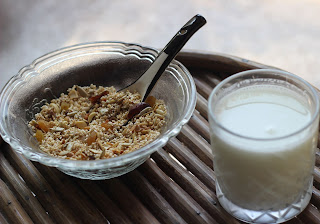Amaranth Granola
Amaranth. How could it not be an Indian word? But the look
of bewilderment on my local grocer’s face when I asked for amaranth after
having discovered it first in Fabindia, made me look into the history of this wonder
grain-that-is-actually-not-a-grain. Turns out Amaranth is actually a Greek word
for a plant native to Mexico (and the old Americas in general), whose seeds
were staple food for the Mayans, Incas and Aztecs. The Spanish colonialists
outlawed it because it was considered sacred, once again demonstrating that
colonialism was both stupid and cruel. It is unrepentant in appropriation as
well, considering how amaranth is now feted as a ‘super food’ like Quinoa and highly
sought after in the West for being gluten free and rich in protein and many
vitamins and minerals. In India, as in many east Asian and African countries,
the leaves of the plant have been more popular. I knew the leaves as the summer
saag called chulai sold in vegetable mandis but I hadn’t connected it
with the laddoo made of its popped seeds (known as seel or rajgira)
and jaggery available in the local stores and then didn’t connect both to amaranth,
till I came across the amaranth muelsi and roasted flour sold in Fabindia and
sought a more affordable version. Turns out the leaves are popular in south
India as well, it is called mullaikeerai in Tamil. Also turns out the
laddoo formula (with honey instead of jaggery) was part of Aztec religious
festivities. Amaranth actually means ‘never fading’ or ‘one which does not
wither’, making for a fascinating story of Greek-Arabic-Sanskrit linguistic
exchanges. I am still trying to find out what it is called in the various
indigenous languages of Mexico and South America
I experimented with roasted amaranth flour by adding them to
cookie and cake dough or dosa batter. Its grainy texture worked well when used
along with other flours but it is not a stand-alone flour. Making the flour at
home is a laborious task, since one has to roast the popped seeds first before
grinding but unroasted works for granola as they get baked in the oven. This
recipe is an not an attempt to replicate the Fabindia muesli, which still is
way too sweet for me, but adapt amaranth according to the granola formula I use
with oats.
The cup measure I am using here is 200ml. I usually use honey
or maple sugar to keep it healthy but you can go with date palm sugar or brown
sugar as well but since they are dry, you will have to melt them with oil in
low heat. Making this during lockdown has meant doing without some of my favourite
berries (blackberry and cranberry in particular). Also, I ran out of vanilla
essence and decided to use a sachet of vanilla sugar instead by lowering the
honey quantity. But it worked out great, so I do recommend it if you don’t mind
a wee bit sugar. This is a recipe which allows for a lot of variation and you
can add in spices like cinnamon or nutmeg too (not more than a couple of
pinches though). In general, you can experiment with the combination of seeds,
nuts and dry fruits, even their quantities, though this ratio worked best for
me. I would suggest keeping the quantity of flax seeds limited to a teaspoon or
so though, otherwise it overwhelms the overall taste. I have the granola with
yoghurt or cold milk, and sometimes with buttermilk if I want a play of sour
and sweet on my tongue.
Ingredients:
Amaranth seeds (popped and unroasted): 4 cups
Coconut oil: 3.5 tbsp
Honey: 3 tbsp
Vanilla: 1 tsp
(or substitute one tbsp honey and vanilla with a sachet of
vanilla sugar)
Seeds Mix (sunflower, melon, pumpkin): ¼ cup
Flax seeds: 1 tsp
Nuts Mix (chopped cashews, almonds, walnuts, pistachios, pines): ½ cup
Dry Fruits Mix (chopped dates, figs and apricots, raisins, dried
berries): ½ cup
Salt: A pinch
Method:
Preheat oven at 150 degree Celsius. Line a baking sheet with
parchment paper. Chop the nuts and dry fruits into small pieces. Measure them only after chopping. In a large bowl, mix coconut oil, honey, vanilla and salt.
Then add the amaranth, nuts and seeds mixes and using hand or a spatula mix
well such that they are fully coated with the liquid mixture. It will stick to
your hand but will not form clumps. Spread out on the baking sheet and bake for
12-15 minutes. Halfway through the baking, stir the mixture thoroughly. When
the amaranth has changed colour to a light golden brown, remove and spread out
on a dry plate. Do the baking in two batches if you have a smaller oven like
me. Keep vigil as one has to be careful to not burn the mixture especially
since ovens work differently. Once it has cooled down, add the dry fruits and
berries mix. You should be able to feel the crunch in the amaranth. Transfer to
an airtight container. Refrigerate if you are not sure of consuming within a
week.



Comments
Post a Comment